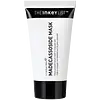Fenty Beauty Cookies N Clean Whipped Clay Pore Detox Face Mask with Salicylic Acid + Charcoal Versus The INKEY List Madecassoside Mask
What's inside
What's inside
 Key Ingredients
Key Ingredients

 Benefits
Benefits

 Concerns
Concerns

 Ingredients Side-by-side
Ingredients Side-by-side

Water
Skin ConditioningKaolin
AbrasiveGlycerin
HumectantBentonite
AbsorbentCetearyl Alcohol
EmollientCaprylic/Capric Triglyceride
MaskingCetyl Ethylhexanoate
EmollientSalicylic Acid
MaskingCharcoal Powder
AbrasiveRheum Palmatum Root Extract
AstringentZingiber Officinale Root Extract
MaskingPanthenol
Skin ConditioningTocopheryl Acetate
AntioxidantButyrospermum Parkii Butter
Skin ConditioningMannitol
HumectantSorbitan Stearate
EmulsifyingCitric Acid
BufferingMicrocrystalline Cellulose
AbsorbentPolysorbate 60
EmulsifyingHydroxypropyl Methylcellulose
Emulsion StabilisingPolyacrylate Crosspolymer-6
Emulsion StabilisingSodium Polyacrylate Starch
AbsorbentPotassium Hydroxide
BufferingPhenoxyethanol
PreservativeCI 77891
Cosmetic ColorantWater, Kaolin, Glycerin, Bentonite, Cetearyl Alcohol, Caprylic/Capric Triglyceride, Cetyl Ethylhexanoate, Salicylic Acid, Charcoal Powder, Rheum Palmatum Root Extract, Zingiber Officinale Root Extract, Panthenol, Tocopheryl Acetate, Butyrospermum Parkii Butter, Mannitol, Sorbitan Stearate, Citric Acid, Microcrystalline Cellulose, Polysorbate 60, Hydroxypropyl Methylcellulose, Polyacrylate Crosspolymer-6, Sodium Polyacrylate Starch, Potassium Hydroxide, Phenoxyethanol, CI 77891
Water
Skin ConditioningCaprylic/Capric Triglyceride
MaskingCetearyl Alcohol
EmollientGlyceryl Stearate Se
EmulsifyingGlycerin
HumectantXanthan Gum
EmulsifyingStearic Acid
CleansingPhenoxyethanol
PreservativeBenzyl Alcohol
PerfumingMadecassoside
AntioxidantInulin
Skin ConditioningSpirulina Platensis Extract
Skin ProtectingMenthol
MaskingTrehalose
HumectantSodium Stearoyl Glutamate
CleansingBisabolol
MaskingEthylhexylglycerin
Skin ConditioningHelianthus Annuus Seed Oil
EmollientDehydroacetic Acid
PreservativeTrisodium Ethylenediamine Disuccinate
Menthyl Lactate
MaskingWithania Somnifera Root Extract
Skin ConditioningSodium Citrate
BufferingSodium Hydroxide
BufferingLecithin
EmollientZingiber Officinale Root Extract
MaskingWater, Caprylic/Capric Triglyceride, Cetearyl Alcohol, Glyceryl Stearate Se, Glycerin, Xanthan Gum, Stearic Acid, Phenoxyethanol, Benzyl Alcohol, Madecassoside, Inulin, Spirulina Platensis Extract, Menthol, Trehalose, Sodium Stearoyl Glutamate, Bisabolol, Ethylhexylglycerin, Helianthus Annuus Seed Oil, Dehydroacetic Acid, Trisodium Ethylenediamine Disuccinate, Menthyl Lactate, Withania Somnifera Root Extract, Sodium Citrate, Sodium Hydroxide, Lecithin, Zingiber Officinale Root Extract
Ingredients Explained
These ingredients are found in both products.
Ingredients higher up in an ingredient list are typically present in a larger amount.
This ingredient is an emollient, solvent, and texture enhancer. It is considered a skin-softener by helping the skin prevent moisture loss.
It helps thicken a product's formula and makes it easier to spread by dissolving clumping compounds.
Caprylic Triglyceride is made by combining glycerin with coconut oil, forming a clear liquid.
While there is an assumption Caprylic Triglyceride can clog pores due to it being derived from coconut oil, there is no research supporting this.
Learn more about Caprylic/Capric TriglycerideCetearyl alcohol is a mixture of two fatty alcohols: cetyl alcohol and stearyl alcohol. It is mainly used as an emulsifier. Emulsifiers help prevent the separation of oils and products. Due to its composition, it can also be used to thicken a product or help create foam.
Cetearyl alcohol is an emollient. Emollients help soothe and hydrate the skin by trapping moisture.
Studies show Cetearyl alcohol is non-toxic and non-irritating. The FDA allows products labeled "alcohol-free" to have fatty alcohols.
This ingredient is usually derived from plant oils such as palm, vegetable, or coconut oils. There is debate on whether this ingredient will cause acne.
Due to the fatty acid base, this ingredient may not be Malassezia folliculitis safe.
Learn more about Cetearyl AlcoholGlycerin is already naturally found in your skin. It helps moisturize and protect your skin.
A study from 2016 found glycerin to be more effective as a humectant than AHAs and hyaluronic acid.
As a humectant, it helps the skin stay hydrated by pulling moisture to your skin. The low molecular weight of glycerin allows it to pull moisture into the deeper layers of your skin.
Hydrated skin improves your skin barrier; Your skin barrier helps protect against irritants and bacteria.
Glycerin has also been found to have antimicrobial and antiviral properties. Due to these properties, glycerin is often used in wound and burn treatments.
In cosmetics, glycerin is usually derived from plants such as soybean or palm. However, it can also be sourced from animals, such as tallow or animal fat.
This ingredient is organic, colorless, odorless, and non-toxic.
Glycerin is the name for this ingredient in American English. British English uses Glycerol/Glycerine.
Learn more about GlycerinPhenoxyethanol is a preservative that has germicide, antimicrobial, and aromatic properties. Studies show that phenoxyethanol can prevent microbial growth. By itself, it has a scent that is similar to that of a rose.
It's often used in formulations along with Caprylyl Glycol to preserve the shelf life of products.
Water. It's the most common cosmetic ingredient of all. You'll usually see it at the top of ingredient lists, meaning that it makes up the largest part of the product.
So why is it so popular? Water most often acts as a solvent - this means that it helps dissolve other ingredients into the formulation.
You'll also recognize water as that liquid we all need to stay alive. If you see this, drink a glass of water. Stay hydrated!
Learn more about WaterZingiber Officinale is more commonly known as ginger.
Ginger root has antioxidant, anti-inflammation, and antimicrobial properties.
The antioxidant properties help protect your body from free-radicals. Free-radicals are molecules that may damage your skin cells. As a result, ginger may help slow down signs of aging such as hyperpigmentation and wrinkles.
Studies show ginger inhibits the enzyme that breaks down collagen. It also helps with:
This ingredient has no negative side-effects and is safe to use unless one has a specific allergy to it.
Ginger originates from Southeast Asia but has spread throughout the world. It is now a common spice used in many cultures.
Learn more about Zingiber Officinale Root Extract